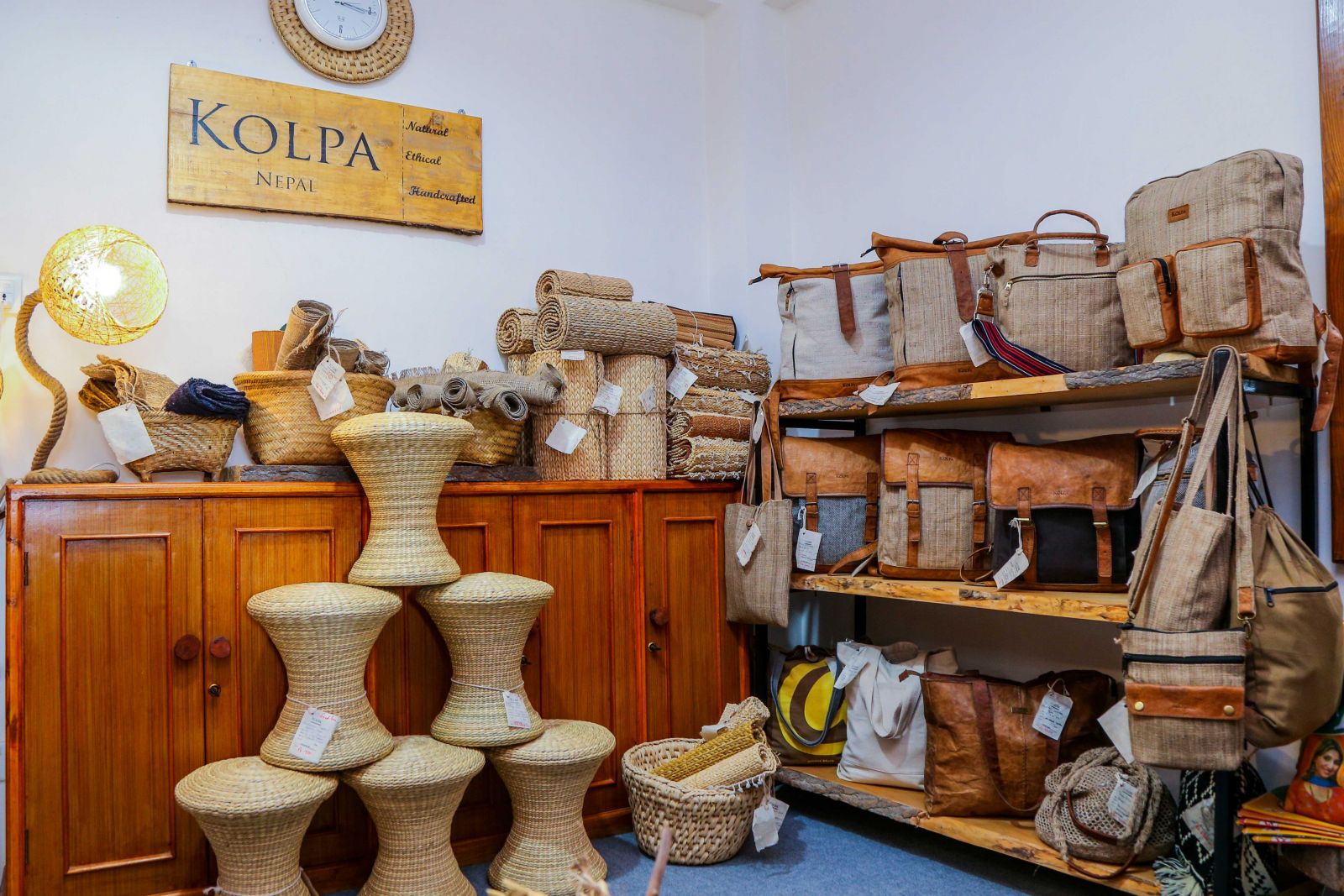 “Come on inside and feel free to look around,” is what Jamba Shahi says, while eagerly working her hands on a wooden corner table, on my visit to the only outlet of Kolpa Nepal—a well-entrenched address in Jhamsikhel. Often ignored when mentioning our rich culture represented through traditional art, I came to witness the world of exquisite craftsmanship of Nepal in this packed space. Nepali craftsmanship is one of our greatest attainments of civilization as an art form that speaks of the length and volume of our history and culture. It has, thus, become a celebrated symbol of our heritage. What makes Kolpa Nepal unique, you say? Kolpa Nepal is one such organization that boasts about collaborating with Nepali artisans by using raw materials produced within Nepal.
“Come on inside and feel free to look around,” is what Jamba Shahi says, while eagerly working her hands on a wooden corner table, on my visit to the only outlet of Kolpa Nepal—a well-entrenched address in Jhamsikhel. Often ignored when mentioning our rich culture represented through traditional art, I came to witness the world of exquisite craftsmanship of Nepal in this packed space. Nepali craftsmanship is one of our greatest attainments of civilization as an art form that speaks of the length and volume of our history and culture. It has, thus, become a celebrated symbol of our heritage. What makes Kolpa Nepal unique, you say? Kolpa Nepal is one such organization that boasts about collaborating with Nepali artisans by using raw materials produced within Nepal.

Rabi C. Malla, a social entrepreneur, founded Kolpa Nepal about four years ago, after a decade of research, with the aim of giving back to the community. Kolpa Nepal— the name came from a lost settlement called Kolpakot, now called Jhaukhel, in Bhaktapur. “Having been born and raised in that area, reviving the lost name of Kolpakot through Nepali products is what I strive for,” says Rabi. Kolpa Nepal focuses on giving the right value and exposure to the unexplored crafting community of Nepal. The space was filled with uniquely designed rucksacks,totebags, wallets, card-holders, rugs, blankets, tables, stools, hats, scarves, and many more, with the hanging lamps descending, warm rays of light over them.
It wouldn’t be wrong to describe the products of Kolpa Nepal as ‘wild crafts’ as everything available is made with raw materials from the wilds of rural regions like Dadeldhura, Dolpa, Sankhuwasabha, Sindhupalchok, and Mustang. I could discern the artifacts from wild and rare materials like allo, pater (wetland grass), bhorla fiber (camel’s foot climber), nettle, goat and yak’s hair, cardamom stems, and leather of goat and buffalo. As unique and atypical these materials seem, even more uncommon are the artisans behind the designs and crafts of Kolpa Nepal.
Most of them come from rural communities of Nepal like Dolpa and Mustang, and moreover, it was an immense pleasure to actually find crafts made by Rautes, the kings of the forests.The Rautes are one of the most typical indigenous groups of Nepal sustaining their unique cultural identity for generations. In an exhibition, Rabi coincidentally came across a member of the Raute Upliftment Association and was blown away by the exceptionally outstanding designs made by Rautes. And, therefore, Kolpa Nepal decided to collaborate with the Rautes’ fascinating wooden bowls, stools, and boats, while also generating financially sustainable livelihood for them.
 I was astounded to discover stacks of handy leather-made wallets at Kolpa Nepal in one specific design, yet in numerous rich shades of brown. When asked about this, Rabi explains, “We play with nature, and nature itself is unique, and its beauty is immeasurable. Unlike machine-made things, behind the making of each itemavailable here, there lies a distinct story, and therefore, is one-of-a-kind in the world. Each comes with an emotional touch to it. The only common aspect among them is the quality that has been the first priority of ours since day one.” The culmination of old skills and techniques with the contemporary lifestyle can be clearly perceived in the polished Kolpa creations.
I was astounded to discover stacks of handy leather-made wallets at Kolpa Nepal in one specific design, yet in numerous rich shades of brown. When asked about this, Rabi explains, “We play with nature, and nature itself is unique, and its beauty is immeasurable. Unlike machine-made things, behind the making of each itemavailable here, there lies a distinct story, and therefore, is one-of-a-kind in the world. Each comes with an emotional touch to it. The only common aspect among them is the quality that has been the first priority of ours since day one.” The culmination of old skills and techniques with the contemporary lifestyle can be clearly perceived in the polished Kolpa creations.
Creating the blooming trend of coexistence of nature and society in Nepal, Kolpa also is operating worldwide delivery. Our unique designs and craftsmanship shines back on who we are and to still be able to find young entrepreneurs like Rabi working passionately for the betterment of our society is a matter of pride. Kolpa Nepal deserves much more recognition and appreciation for giving the platform for keeping our artisans and their compositions alive and kicking.











